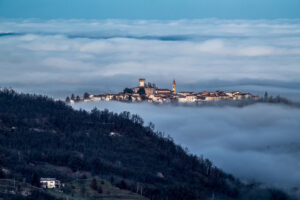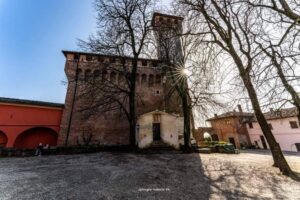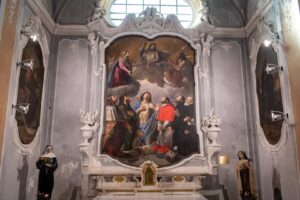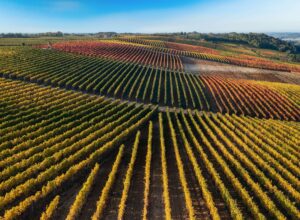A small wine-growing center in Alto Monferrato, its origin dates back to the Roman-Augustan period: with the foundation of Libarna, a minor road network was born that reached the Via Aemilia Scauri, in the section that led from Dertona to Aquae Statiellae. Thus it was that, along this route, the first demic settlement arose that would originate the village of San Cristoforo.
In the 10th century, because of its strategic location, a tall and solid irregular polygon tower, called the Gazzolo Tower, was erected and was part of a sighting system.






What to see in San Cristoforo
- CASTELLO DEGLI SPINOLA
- “CASA LUNGA”
- LA FORESTERIA
- CHIESA PARROCCHIALE DI SAN CRISTOFORO MARTIRE
- LE CORTI
- CHIESA CAMPESTRE DELL’ANNUNZIATA
It is an elegant manor characterized precisely by the Gazzolo Tower. The entrance is defended by a courtyard of arms placed outside the wall block (the only castle with this configuration in the area).
The structure is tangent to a lower and wider fortified circle, enclosing the stables, servants’ quarters, chapel, and a small Italianate garden.
Formerly, the castle enclosed a picture gallery, with valuable works, and a library with volumes and papers of high historical and literary interest. Over time, it was gradually stripped, including of its furnishings.
Legend has it that inside the manor house, a strange book is still hidden, containing terrifying stories, to the point that, anyone who reads them, pervaded by fear, can no longer approach the village.
San Cristoforo Castle returned to Spinola ownership in 1826 and remained in the hands of the noble family until 1957, when it was sold to private individuals.
The building, which dates back to the 15th century, had several uses: used as a cellar, wine cellar and pressing room for the basement, and for the upper floors used as an auxiliary dwelling.
It constitutes the west body of the complex and now houses the municipal boardrooms.
Built in the 15th century, constitute the west body of the complex. It was intended for the reception of guests and strangers and, on the second floor, preserves a passageway that once connected the church and the castle.
Simultaneous with the building of the castle, a small aristocratic chapel was erected, dating from around 1582 and serving the marquises and the resident population. In 1894 it was expanded to become the town’s parish church.
The parish was by right of lay patronage, that is, the appointment of the parish priest was made by the marquis. A situation that remained unchanged until the mid-20th century.
Since 1800 the parish has been part of the Diocese of Acqui.
The interior is single-nave and encloses three small chapels: on the right side is the altar of the Sacred Heart of Jesus; next is the Chapel of the Saints with an altarpiece on the altar, the work of G.B. Carlone, and on the opposite wall opens the chapel dedicated to Our Lady of the Rosary, containing the statue of the Virgin surrounded by fifteen panels, representing the mysteries of the Rosary.
They are complexes of dwellings and barns, enclosed by walls, bearing witness to the rural dwellings of the area.
In the vicinity of the castle we find two typical examples, “il Calò” and “Corte dei Bobbi,” once used as stables and dwellings.
Built around 1700, it was used for festive celebrations concerning the blessing of fields and animals.
Around it, unknown or deceased people were buried in the woods bordering the village.
In the second half of the 19th century the church was enlarged and assumed its present structure, with three naves. The building is in Baroque style, and its interior contains a statue of the Sacred Heart, by Righetti, and a very old statue of the Madonna Child.




































